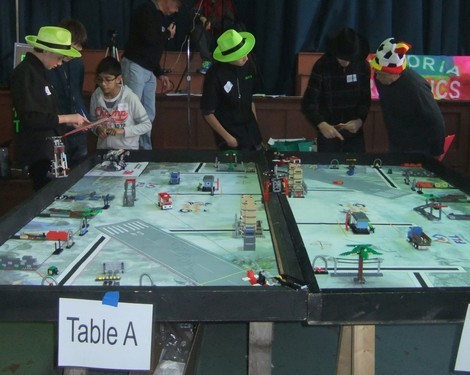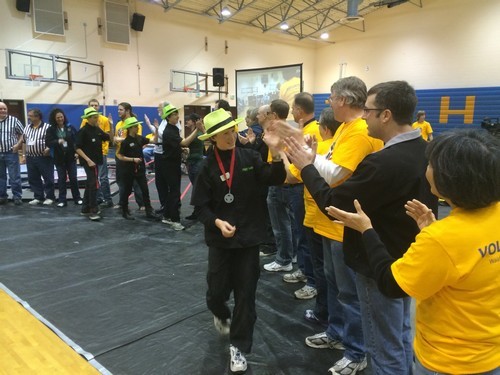The Canadian FTC Championships were held in Edmonton on Feb. 8, 2015. We had been looking forward to playing with Canadian teams at an event.
Category: Uncategorized
District Championships, 2015
This season, the FIX IT team was part of the Knuth League in northern Washington State. After playing two league events (16 matches), 3491 was ranked 7th in our district. The next event was the Pasteur District Championship on Jan. 11, 2015. Continue reading “District Championships, 2015”
Kick-Off 2014/15
The kickoff was held in the Microsoft campus in Redmond on September 6, 2014. There were a lot of teams; more than last year. The game was revealed! Continue reading “Kick-Off 2014/15”
FTC Block Party Season
FLL Event 2013
The FIX IT team helped at a practice tournament for the local FLL teams on December 7, 2013. We helped by running the tournament field, getting teams to interviews, and doing odd jobs.

It was fun bringing the teams to the interviews because we got to spend time with the teams as they were getting ready for the interviews. It was interesting to be involved in running a tournament, not just being in the tournament. We got to see more of an overview, rather than just the narrow focus on what we need to for the competition.
EV3 vs. NXT
We had an opportunity to see and handle the new LEGO MINDSTORM EV3 at the FIRST World Championships in St. Louis. We didn’t not have a lot of time to evaluate the EV3. These comments are just initial impressions from FLL and FTC team members, who have been working with the NXT for 6 years.
LEGO has posted a comparison of features between the EV3 and NXT. The comparison includes lots of new features that we didn’t get to test. Mostly, we were quickly checking to see what we thought for our FLL and FTC teams. FTC has announced their competition won’t be using the EV3 in fall 2013.
[[MORE]]
The EV3 itself and its motors, are larger than the NXT and its motors. The difference isn’t huge, but if you are trying to build a very small robot, the difference is noticeable. There are two larger drive motors and then a smaller motor that can be used for attachments. The option to have a smaller motor for attachments is a good idea.
There are many new sensors, but we didn’t get to work with them enough to form an opinion. The speakers look like they should be much better.
The software uses icons, similar to NXT-G, but they are wired more like Robolab. They can be automatically connected like NXT-G, or you can specifically wire them like Robolab.
It is Linux based, and has a different way of selecting which program to run. Likely that will just take some adjusting for people familiar with the NXT.
EV3 software screen layout seemed better. Rather than blocks down the left hand side, there were 4-5 categories across the bottom. Within each category were the actual icons.
There are four motor ports and four sensor ports. The EV3 has a SD slot so that you can increase the memory. There’s a USB hub that we didn’t get to explore. The cable to connect to the computer had different plugs.
We talked with one of the testers. The EV3 has very long turn on and turn off cycles. The estimate is 30 seconds from when you push the on button, to when it is ready to start. The NXT takes about 3 seconds.
We’re all use to laptops taking a few minutes to boot-up, but it will be harder for kids who want to push a button and get started. The extra time will add up during competitions when a team doesn’t turn their robot on, or even worse, it automatically powers down while they are waiting in line.
The turn-off cycle takes about 45 seconds. Again, it’s not a huge amount of time, but compared to about 3 seconds for the NXT, it is a significant change.
We talked to one tester who said that any time the battery was replaced, the EV3 reset the firmware and all the stored programs were gone. This ‘feature’ has significant implications for competition teams who want to have fresh batteries for each match. Many FLL teams just plug in their robot between matches, they should be fine.
FTC teams usually replace their batteries frequently at events. This ‘feature’ is a disaster for those teams. It is reasonably quick, maybe 2 minutes, to remove the NXT from the robot and pop in a new battery just before a match starts. With the EV3, the team would have to replace the battery (2 minutes), turn it back on (30 seconds), connect to a computer and download their programs again. It will easily take over 5 minutes, possibly delaying a match.
A staff person from the company that wrote the software ‘thought’ that if you waited completely through the shut down cycle (minimum 45 seconds) before removing the battery, it might not reset the firmware. Unfortunately, we didn’t get to test it.
Some of the issues with the EV3 could be fixed with a software update, but the size and battery/firmware issues are hardware and there is no easy fix. It would likely take a hardware upgrade to correct it. At this point, we haven’t decided if we will order one of the early EV3s. It’s tempting to wait 6-8 months and see how they do.
St. Louis 2013 – Day Three
Today we only had two matches and they didn’t start until the afternoon. That let us fix a problem we had with some cables on our lifter getting snagged, and let us have some time on the practice fields where we developed a new autonomous program to go to the far side of the field, mostly to try and mess up the other alliance, but with a chance to score too.
St. Louis 2013 – Day Two
Today, the team had six matches. We won four and lost two.
The good news is that all the matches were tough, that means we have lots of ranking points.
St. Louis 2013 – Day One
Today was set up, judging, inspections and opening ceremonies.

